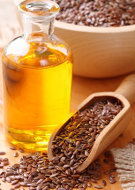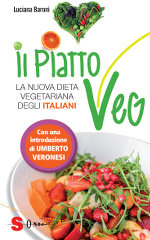
Omega-3
These fatty acids have already been discussed in food group of nuts and oilseeds and that of fats, since omega-3 fatty acids as are contained in nuts, flaxseeds and flaxseed oil.
In the VegPlate figure, foods rich in omega-3 are represented as a dark red area in these 2 groups.

As already mentioned, the fatty acids of the omega-6 and omega-3 family, are essential, as they can be introduced only with diet, and cannot be produced by our bodies. Omega-6 fatty acids are even too abundant in the diet, while omega-3 are much less common.
The most convenient way to obtain them, if you have a store that keeps the oil in the refrigerator section (otherwise its omega-3 content spoils), is precisely from this oil, which contains omega-3 in the form of ALA (alpha-linolenic acid, the precursor of long chain omega-3 fatty acids).
Otherwise, you can consume freshly-ground flaxseed, ground as needed with a coffee-grinder, as well as walnuts. Algae used in cooking are not a good source of omega-3, they contain very small quantities.
Flax seed oil can be used as a condiment for cold dishes or mixed with yeast flakes or minced nuts, as a paté to spread on bread.
Omega-3 from animal sources
A note about animal sources of omega-3: even some fatty fish (salmon, trout, herring) are good sources of omega-3 long chain fatty acids (eicosapentaenoic acid, EPA and DHA, docosahexaenoic acid). However, fish also contains other fats: between 15% and 30% of the fat in the fish consists of saturated fats (i.e., "bad" fats). A little less than in beef and chicken, but much, much more than in plants. And it is precisely in the fat of fish that are found concentrated all the pollutants that are poured into the water. Fish also contains cholesterol.
From an economic point of view, it is unthinkable to eat fish every day for the general population: fish is much more expensive than walnuts and flaxseed and also it should be consumed only specific types, few are rich in omega-3.
Finally, it's not sustainable, and it is impossible in practice to increase fish consumption for the entire population. Already, a fish consumption at current levels has caused devastation due to the wild fishing, and all the experts agree that the situation is no longer sustainable.
Even the supplementation of omega-3 from fish oil capsules is not a healthy choice, as is being touted: various scientific studies have shown that most of the allegations of the wholesomeness of fish oil are unfounded, and also the same environmental concerns apply.
In fact, therefore, this nutrient is not realistically achievable from animal sources. For everyone, the only possible sources of omega-3 fatty acids are walnuts and flax seeds, and in particular phases of the life cycle, the algal oil contained in some supplements, preferred source of DHA (see below).
Foods rich in omega-3 of VegPlate
In VegPlate, foods rich in omega-3 are represented as a different colored area in the Group of nuts and oilseeds and that of fats. Two servings of foods rich in omega-3 are recommended daily. Each serving provides about 2.5 g of these fatty acids in the form of ALA. One serving thus equals:
- 5 mL (1 cucchiaino, circa 5 g) di olio di semi di lino;
- 5 mL (1 teaspoon, about 5 gm) of flaxseed oil
- 15 mL (3 teaspoons, approximately 10 g) of ground flaxseed;
- 30 g walnuts (about 6 walnuts);
- 15 g of ground chia seeds.
For the best balance between calories, calcium, omega-3, in low-calorie diets, preference should be given to flaxseed oil or flaxseeds, with respect to walnuts and chia seeds.
Omega-3 fats during pregnancy and lactation
During pregnancy and lactation, the number of servings of foods rich in omega-3 is always equal to two, as in other stages of life. However, it may be advisable, after consultation with the gynecologist, also associating 100-200 mg of preformed DHA, from algal source supplements (listed at the bottom of the page). This is to ensure the availability of DHA, also in case of reduced functioning of the mechanisms for conversion. The amount of DHA that your body does not use can be retro-converted and used for energy purposes.
Omega-3 fats during weaning
The weaning child needs only one serving of foods rich in omega-3, not 2 as in adults. Flaxseed oil is certainly the most practical to use and easier to take for the child under one year. Just add 1 teaspoon of flaxseed oil per day to a warm meal. This, however, only if the store has a refrigerator section for the linseed oil that respects the cold chain, otherwise the product should be avoided because it would contain no useful omega-3.
As a precautionary measure, the possible supplementation of preformed DHA, in an amount of about 100 mg per day (also possible with 200 mg on alternate days) should be assessed with a pediatrician. Vegan DHA supplements are shown at the bottom of this page.
In case the tablet form is chosen, it should be pulverized, while for preparations in capsules or beads, just drain the algal oil immediately prior to use.
Long-chain omega-3 from microalgae
In special cases (pregnancy, lactation, infancy), long-chain preformed omega-3 fatty acid (EPA and DHA) supplementation should be taken into consideration as a precaution, which can be done from algal oil-based products, obtained from microalgae. We recommend the following products, in which there is the certainty that the capsule does not contain animal ingredients (it usually contains them).
Energy Balance - Ovega3 life DHA
Algal DHA, 200 mg per capsule (Pack of 60 or 180 capsules). Can be ordered from Switzerland from the manufacturer's website:
Go to product description
Dr. Rath Omega-3 Vegan
Algal DHA and EPA, 250 mg per capsule (of which 160 mg of DHA); plant gel capsules (60 capsules). Can be purchased online.
Go to product description
VegPlate - the books

